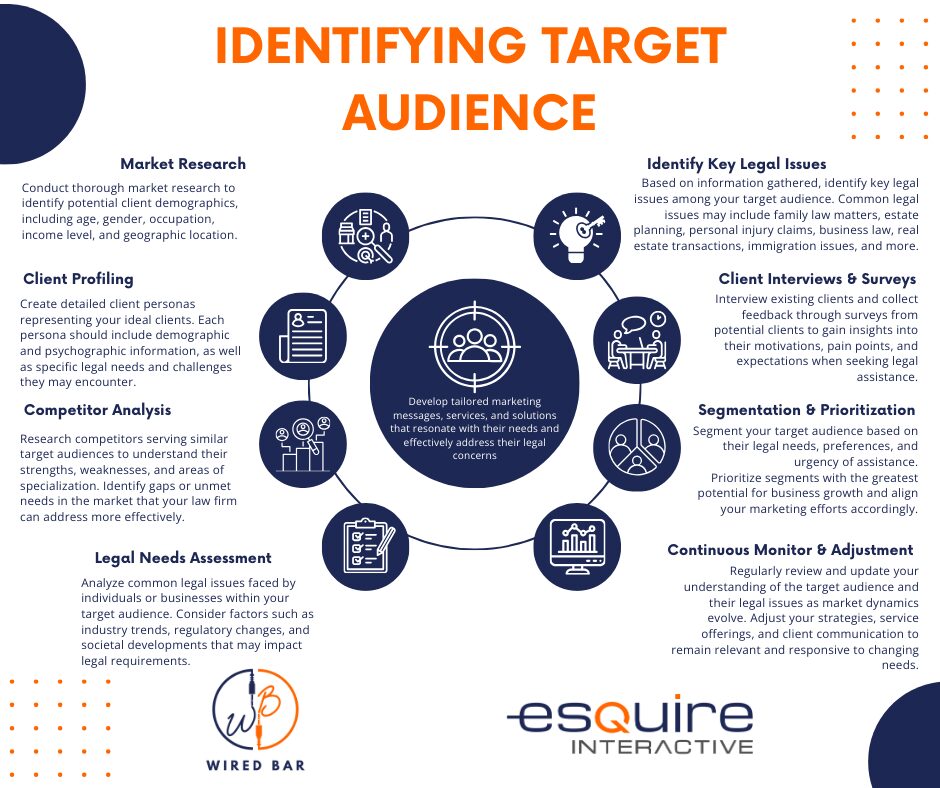
Unveiling Your Law Firm’s Target Audience: A Strategic Approach
In the ever-evolving landscape of legal services, understanding your law firm’s target audience is pivotal to shaping effective marketing strategies and delivering tailored solutions. By delving deep into the demographics, psycho-graphics, and legal needs of your potential clients, you can not only enhance your firm’s visibility but also establish meaningful connections that resonate with their unique requirements. Here’s a comprehensive road map to help you identify your target audience and effectively address their key legal issues. By understanding these nuances, you can craft a valuable marketing strategy tailored to your ideal clientele, maximizing the impact of your marketing efforts.
Crafting Effective Client Profiles through Comprehensive Market Research:
Begin by conducting extensive market research to uncover the complexities of your potential client base. Dive into demographic factors such as age, gender, occupation, income level, and geographic location. Additionally, explore psycho-graphic elements such as values, attitudes, lifestyles, and behavior patterns, as these nuances significantly shape legal needs and preferences.
After pinpointing your potential client base, the next step is to create detailed client profiles. This involves crafting comprehensive client personas that embody your ideal clients. Each profile should blend demographic and psycho-graphic insights, along with specific legal challenges and needs they might face. This personalized approach lays the foundation for understanding and catering to the diverse spectrum of your target audience.
Once you have established the foundation for your potential client profiles, you can further enhance your understanding by engaging in meaningful conversations with existing clients. Through these interactions, you can gain invaluable insights into their motivations, pain points, and expectations when seeking legal assistance. To complement these discussions, utilize surveys targeting potential clients to uncover their legal concerns, preferences for legal services, and decision-making criteria. This first hand feedback lays the groundwork for client-centered service.
Strategic Analysis and Segmentation: Understanding Legal Needs for Targeted Outreach:
Initiate a thorough analysis of the common legal issues encountered by individuals or businesses within your target demographic. Factor in industry trends, regulatory changes, and societal developments that could shape legal requirements. This proactive assessment equips your firm with foresight to anticipate and address evolving legal landscapes effectively.
After assessing the legal needs of your target demographic, you’ll need to consolidate the gathered insights to identify the most common legal issues faced by your target audience. These issues span across diverse realms such as family law matters (e.g., divorce, child custody), estate planning, personal injury claims, business law (e.g., contracts, intellectual property), real estate transactions, immigration issues, and beyond. Understanding these nuances enables you to tailor your services accordingly.
Once you’ve identified the most prevalent legal challenges your clients may encounter, it’s crucial to segment your target audience based on their specific legal needs, preferences, and urgency of assistance. By prioritizing segments with the greatest potential for business growth, you can strategically align your marketing efforts. This targeted approach ensures optimal resource allocation and amplifies the impact of your outreach endeavors.
Competitive Analysis and Adaptive Marketing Strategies:
To thoroughly identify your target market, it’s essential to conduct a comprehensive evaluation of competitors who cater to similar audiences. This involves identifying their strengths, weaknesses, and areas of specialization to discern market gaps or unmet needs. This competitive intelligence allows your firm to find a unique niche and offer exceptional value to clients.
Additionally, embracing a culture of continuous learning and adaptation is crucial. Regularly review and update your understanding of the target audience and their evolving legal issues. Stay attuned to shifting market dynamics and adjust your marketing strategies, service offerings, and client communication accordingly. This agile approach positions your firm as a dynamic ally responsive to the evolving needs of your clientele.
By carefully understanding your target audience and their main legal issues, you can create customized marketing messages, services, and solutions that truly meet their needs. Continuously refining your understanding of the target audience and staying responsive to market dynamics, your firm can position itself as a dynamic ally, ready to meet the evolving needs of its clientele. With this comprehensive approach, you are ready to maximize the impact of your marketing efforts and drive sustainable growth for your law firm.
